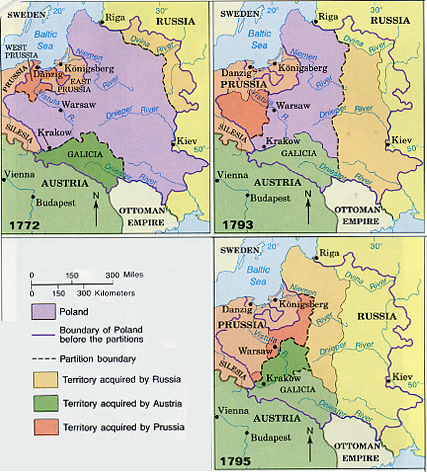 |
| Partitions of Poland |
The three partitions of the Polish-Lithuanian Commonwealth, which took place in 1772, 1793, and 1795 resulted in the end of independent Poland and the incorporation of its lands into Prussia, Russia, and Habsburg Austria.
In the early 18th century, the Polish-Lithuanian Commonwealth was undermined by various European powers, especially through the Polish parliament, the Sejm, where a single member could exercise the right of veto and block any measures being introduced by the body.
This had allowed the commonwealth to remain neutral during the Seven Years’ War (1756 – 63), although it sympathized with France and Austria, allowing Russian soldiers to cross its territory to fight the Prussians after Russia entered the war as an ally of the French and Austrians.
  |
At the end of the war, Frederick the Great of Prussia wrecked the Polish economy and sought to undermine the country. In 1768 the Russians were involved in fighting the Ottoman Empire and won such easy victories over the Ottomans that the Austrians were nervous that the victorious Russians might attack them. Frederick II decided to refocus the Russian attentions on Poland.
On February 6, 1772, representatives of the Prussian and Russian governments, meeting at St. Petersburg, the Russian capital, decided to annex large parts of Poland, with the agreement of partition signed 13 days later in Vienna, and the Austrian government also gaining part of the country. The annexation took place on August 5, 1772. Some parts of Poland resisted with Tyniec holding out until March 1773 and Kraków falling on April 28—the garrison of the latter being exiled to Siberia.
Essentially the result of the partition was that the Austrians took over areas around Kraków and Sandomir (but not Kraków itself), as well as Galicia. The Prussians took the area around Danzig(Gdan´sk) and areas of western Prussia, along with control of some 80 percent of the total pre-partition foreign trade; with the Russians annexing the parts of Livonia they had not already seized, as well as Vitebsk, Polotsk, and Mstislavl, in modern-day Belarus. The Polish sejm was forced to accept the partition, which it did on September 30, 1773.
The Poles had hoped to get the support of Britain and/or France, but their plans came to nothing. The new Polish government, having lost large amounts of territory and most of its foreign revenue base, signed the Polish-Prussian Pact of 1790.
This effectively allowed the next partition to take place and when the new Polish Constitution of 1791 enfranchised much of the middle class, the Russians were angry and regarded the action as aggressive, coming so soon after the French Revolution. On January 23, 1793, the Second Partition took place with Prussia and Russia seizing more land—the former taking Danzig.
The Poles under Tadeusz Kos´ciuszko led an uprising that lasted from March until October 1794. This forced the Russians and the Prussians into a closer military alliance, and they decided, along with Austria, that it was easier to annex the remainder of Poland. This was achieved on October 24, 1795, when the Third Partition took place, ending Poland’s independence.
Napoleon I tried to restore Poland during the Napoleonic Wars